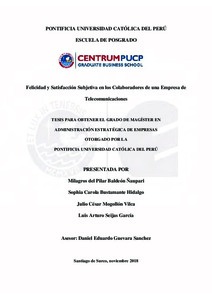| dc.contributor.advisor | Guevara Sánchez, Daniel Eduardo | |
| dc.contributor.author | Baldeón Ñaupari, Milagros del Pilar | es_ES |
| dc.contributor.author | Bustamante Hidalgo, Sophia Carola | es_ES |
| dc.contributor.author | Mogollón Vilca, Julio César | es_ES |
| dc.contributor.author | Seijas García, Luis Arturo | es_ES |
| dc.date.accessioned | 2018-12-11T22:26:43Z | |
| dc.date.available | 2018-12-11T22:26:43Z | |
| dc.date.created | 2018 | |
| dc.date.issued | 2018-12-11 | |
| dc.identifier.uri | http://hdl.handle.net/20.500.12404/13119 | |
| dc.description.abstract | La presente investigación se ha realizado con la finalidad de describir la felicidad y la
satisfacción subjetiva de los colaboradores de una empresa de telecomunicaciones ubicada en
Lima, Perú, en el año 2018. Es un estudio con enfoque cuantitativo, de diseño no experimental
transversal y con alcance descriptivo, que hizo uso de la encuesta virtual mediante la intranet
de la empresa y la internet.
Esta investigación utilizó dos instrumentos de medición, cada una conformada por
diversas dimensiones o escalas de evaluación. El primero fue la Escala Factorial para Medir la
Felicidad (Alarcón, 2006) y el segundo el Índice Chamba 1.0 (Yamamoto, 2012). El estudio
evaluó a 91 colaboradores, de los cuales 18 fueron mujeres y 73 hombres, el mínimo grado de
instrucción con el que cuentan es nivel técnico, existen colaborados que tienen más de 20 años
laborando en la empresa y los sueldos oscilan entre S/. 5,000.00 y S/. 20,000.00.
Los resultados obtenidos en el análisis estadístico de ambos instrumentos fueron
altamente positivos, ya que más del 80% de colaboradores de acuerdo con las respuestas dadas
en las cuatro dimensiones de la Escala Factorial para Medir la Felicidad se sienten entre feliz
y altamente feliz y, respecto al Índice Chamba 1.0 más del 90% de los colaboradores, ha
respondido en sus dos escalas, que sus expectativas de felicidad han sido cubiertas o superadas
respecto a sus percepciones actuales de la misma. Cabe resaltar, que debido a que existe un
porcentaje de colaboradores que se sienten medianamente felices; y que en relación a la
percepción de logros en los factores: chamba y hogar, y sentirse bien en el trabajo, tienen
algunas puntuaciones de insatisfacción, se recomienda a la empresa implementar los Planes de
Mejora desarrollados en las Tablas 18, 19, 20, 21 y 22 para cada instrumento; así también se
recomienda realizar cada seis meses nuevos estudios de felicidad a la misma población de
colaboradores para analizar su evolución con respecto a las propuestas implementadas.
Palabras Claves: Felicidad, satisfacción subjetiva, felicidad en el trabajo, percepción. | es_ES |
| dc.description.abstract | The present investigation to describe the level of happiness and subjective satisfaction
of the collaborators of a telecommunications company located in Lima, Peru in 2018. This is a
study quantitative, non-experimental transversal and with descriptive scope, it used of the
virtual survey through the intranet of the company and the internet.
This investigation used two measurement instruments, each one conformed by different
dimensions or scales of evaluation. The first was the Factorial Scale to Measure Happiness
(Alarcón, 2006) and the second was the Chamba Index 1.0 (Yamamoto, 2012). The study was
applied to 91 collaborators, it consisted by 18 women and 73 men, the minimum level of
instruction was technical, there are collaborators who have been working in the company for
more than 20 years and the salaries range from S /. 5,000.00 and S /. 20,000.00.
The statistical analysis of both instruments were several positive since more than 80%
of collaborators in the four dimensions of the Factor Scale to Measure Happiness said to feel
happy or highly happy and, with respect to Chamba Index 1.0 more than 90% have responded
in both scales, that their expectations of happiness have been met or surpassed with respect to
their current perceptions of it. Finally, and due to that there is a percentage of employees who
feel fairly happy, and that in the achievements of home and work, and feel good at work, they
have some dissatisfaction scores , it is recommended that the company implement the
Improvement Plans shows in Tables 18, 19, 20, 21 and 22 for each instrument and do new
studies every six months.
Keywords: Happiness, subjective satisfaction, happiness at work, perception. | es_ES |
| dc.language.iso | spa | es_ES |
| dc.publisher | Pontificia Universidad Católica del Perú | es_ES |
| dc.rights | info:eu-repo/semantics/openAccess | es_ES |
| dc.rights.uri | http://creativecommons.org/licenses/by-nc-nd/2.5/pe/ | * |
| dc.subject | Felicidad y satisfacción laboral | es_ES |
| dc.subject | Felicidad y satisfacción profesional | es_ES |
| dc.subject | Investigación cuantitativa | es_ES |
| dc.title | Felicidad y satisfacción subjetiva en los colaboradores de una empresa de telecomunicaciones | es_ES |
| dc.type | info:eu-repo/semantics/masterThesis | es_ES |
| thesis.degree.name | Maestro en Administración Estratégica de Empresas | es_ES |
| thesis.degree.level | Maestría | es_ES |
| thesis.degree.grantor | Pontificia Universidad Católica del Perú. CENTRUM | es_ES |
| thesis.degree.discipline | Administración Estratégica de Empresas | es_ES |
| renati.discipline | 413307 | es_ES |
| renati.level | https://purl.org/pe-repo/renati/level#maestro | es_ES |
| renati.type | https://purl.org/pe-repo/renati/type#tesis | es_ES |
| dc.publisher.country | PE | es_ES |
| dc.subject.ocde | https://purl.org/pe-repo/ocde/ford#5.02.04 | es_ES |






